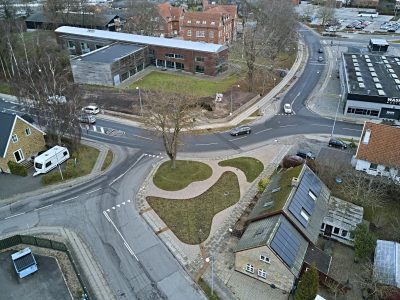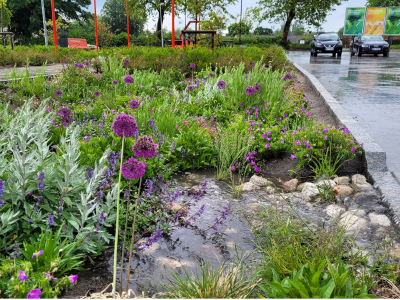Local stakeholders: Ministry of Environment of Denmark, Environmental Protection Agency, Odense Kommune, Odense Boldklub and local residents The case study is located in the Bolbro area in Odense. It is undergoing a large transformation (i.e. demolition of large industrial areas, construction of dense housing and green infrastructure). The overflow receiving water bodies (Bolbro Rende/Odense Fjord) do not meet the requirements set out by EU Water Framework directive (thus, stormwater outlets are being restricted) and monitoring of the network is limited. The local recipient is a small creek (Bolbro Rende) in an urban setting. The pollution load in this creek is already under study. Several initiatives have been undertaken and are being planned to reduce this pollution load. Several Nature-Based Solutions (NBS) have already been implemented in the area, mainly bioretention facilities (rain gardens with filter soil) with and without underlaying drains. These facilities have different types of catchment areas, for example a primary road with heavy traffic; a secondary road with less traffic and parking lot. Some of the nature-based solutions in the area have been monitored, and D4RUNOFF will use these established monitoring facilities. Data from these projects can be used in D4RUNOFF if needed. Finally, residents in the area have been involved in different projects over the last years, many incorporating nature-based solutions. The community will continue to be engaged with through D4RUNOFF. Aerial view of Bolbro area NBS implemented in the Bolbro area NBS implemented in the Bolbro area Implement and assess of new NBS: rain gardens with filter soil integrated in the roads for collecting, filtrating, infiltrating, and discharging storm water (existing: 20-30) Carry out non-target analysis to determine the presence and number of specific contaminants and CECs (this includes the concentration of various metals as well as the presence of multi-resistant bacteria) and track their source and fate before stormwater outlet to the receiving water bodies Incorporate new sensors to enable data gathering Develop water sampling techniques in existing ponds and NBS to evaluate its effect on the CECs Test and validate the project results in a relevant environment Assess the replicability of the project results High-resolution methods for suspect and NTS for CECs Developed by VCS Online sensors for water pollutants Developed by INL Laboratory MCDA applied to dynamic design of hybrid urban drainage solutions Developed by the University of Cantabria DSS applied to hybrid urban drainage solutions, ABM and social network analysis Developed by ITG Thor Hougaard (VandCentreSyd, VCS) tzh@vandcenter.dk Pontedera, ItalyOdense, Denmark
Led by VCS & University of Southern Denmark




Objectives
Solutions implemented
Contact
More D4RUNOFF case studies…


